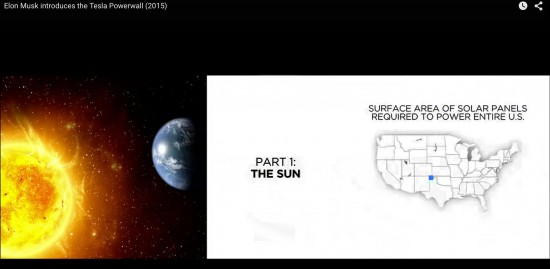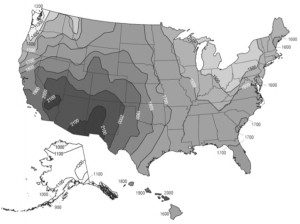































During Elon Musk's presentation of Tesla Powerwall, a battery system that lets you store energy to power your home, he shared a slide showing a small area of the Texas panhandle -with a small blue square representing the land area necessary to produce enough solar power to meet the entire electric power needs of the United States.
 "...very little land is required to get rid of all fossil fuel electricity generation in the United States." Elon Musk
"...very little land is required to get rid of all fossil fuel electricity generation in the United States." Elon MuskAs you might expect, this generated quite a bit of controversy about whether or not his assertion is even within the realm of possibility.
Does Musk's claim pass the smell test?
To find out, there are a few facts required and some simple calculations to be made. I need to find out how much electricity the United States uses, then I need to find out how big a solar farm would be needed to generate that much electricity, then I need to figure out how much land that would take.
I started searching for recent total power production figures for the U.S. and found the 2015 Annual Energy Outlook for the U.S., published by the Electricity Information Administration, which reports that 3,836 billion kilowatt-hours (kWh) were generated in the U.S. in 2013.
Next we need a solar farm size and production rating reference. A convenient one with widely published statistics is the Topaz Solar Farm in the California Mojave desert. A very impressive facility, it has a badge rating of 550MW and is comprised of 9 million solar panels. There are a variety of sizes reported in different articles about the farm, but the one that the Topaz website publishes is 9.6 square miles and takes into account spacing, roads, etc.
The Topaz Solar Farm statistics give the size in megawatts (550), but how many kilowatthours will that generate? There are a number of solar sizing calculators available on the web. The following was taken from www.solarpowerrocks.com and utilizes a solar intensity map published by National Renewable Energy Laboratory (NREL):
"Interested to know how many kilowatt hours (kWh) your new solar panel system will kick out per year? All you must do is multiply the size of your system in kW by 78% of the number in the shaded region you live in the map below. Then, bingo you're good to go!"


Detailed calculations are given in the footnote, but essentially 476.4 Topaz Solar Farms would be required to produce the power generated in the United States in 2013. Since Topaz is 9.6 sq. miles, 476.4 Topaz solar farms would be 4573.44 sq. miles or a square 68 miles on a side.
By comparison, Lake Powell is 254.1 sq. miles, Rhode Island is 1,212 sq. miles and Connecticut is 5,543.41 sq. miles. I leave to the reader whether an area of land more than 80% the size of Connecticut is "...very little land..."
Topaz has 9 million panels so to have a badge rating sufficient to equal the 2013 U.S. total electric power would require at least 4.3 billion panels. As to reliability, maintenance requirements (without cleaning, panel efficiency declines as dirt accumulates), construction costs, land costs and environmental impact -leave those for another day.
Elon Musk's point was, of course, that utilization of solar power on a large scale requires energy storage. This would be especially true to the extent that there is limited geographic diversity. If the hypothetical U.S. solar farm was one contiguous area, all 9 billion panels would experience pretty much identical weather, cloud cover, and day/night. The NREL/solarpowerrocks.com analysis also averages the annual sunlight, so there needs to be additional calculation for minimum solar intensity during winter months as opposed to summer months.
The Texas panhandle is at approximately 35 degrees North latitude. The length of the day at Summer Solstice is approximately 15 hours. The length of the day at Winter Solstice is approximately 9 hours. This would imply an increase in area of 25% would be necessary for adequate winter generation.
So how does it smell?
The size of the area on Musk's presentation is not specified, but it seems approximately correct. However, it does ignore a huge number of practical realities, such as distance from the load centers, availability of transmission lines and the logistics of obtaining, installing and managing nine billion solar panels. To be fair, Musk was not proposing the construction of such an installation, but rather that most of this could be on rooftops of homes, businesses, industrial warehouses and the like.
As to how this relates to the Tesla Powerwall, there are a number of requirements to be met by electric power storage for the grid:
The Powerwall also does not directly address higher energy intensity uses. High rises, multi-tenant buildings, dense urban areas, light industry, etc. have energy use that far exceeds their areal footprint. This doesn't mean they can't utilize solar power, it only means that the panel area requirements will need to be satisfied some distance away where space is available. That power will then need to be carried by transmission and distribution lines for delivery to the user -an activity that will sound very familiar to some.
What does this mean for Cisco?
Although it is possible to imagine a future where every building will be completely standalone and energy self-sufficient, it seems much more reasonable that efficiency and reliability are better served by the ability to interconnect distributed energy resources of all types. Management of the multi-directional flows of electricity, matching up availability with demand and making it all work securely from an electric power standpoint, a data and information standpoint, and a financial commercial standpoint requires communication networking of all those distributed energy resources. This is exactly what Cisco refers to as the Internet of Everything.
Footnote: Calculation Details
The Texas panhandle is in the "1900" region of the NREL map. According to the EIA 2015 Annual Energy Outlook, total electric power generated in the US in 2013 was 3,876 billion kWh, or rewritten for ease of calculation: 3.8
 Горячие метки:
Internet of Things (IoT)
Internet of Everything (IOE)
IoE
Производство и сбыт
1. Энергетика
solar
Industrial collaboration
Горячие метки:
Internet of Things (IoT)
Internet of Everything (IOE)
IoE
Производство и сбыт
1. Энергетика
solar
Industrial collaboration